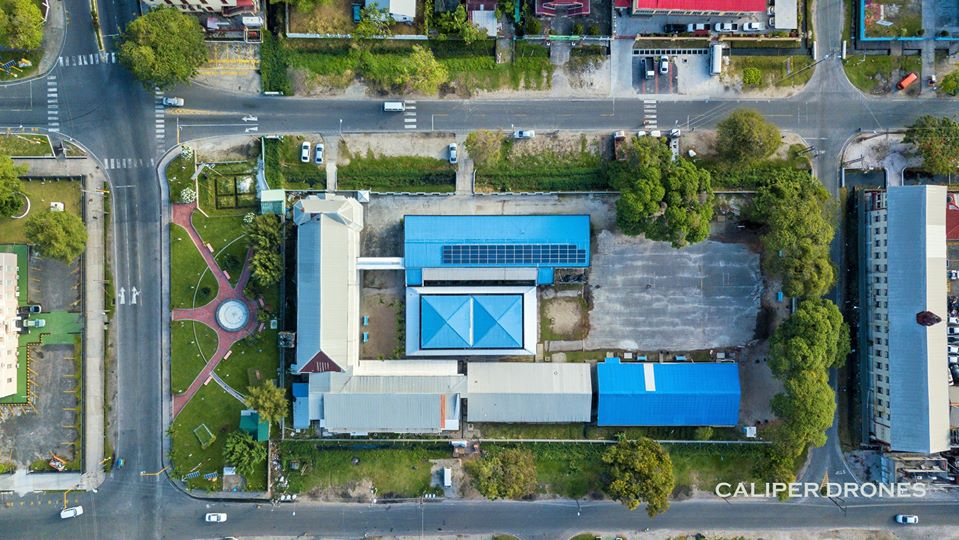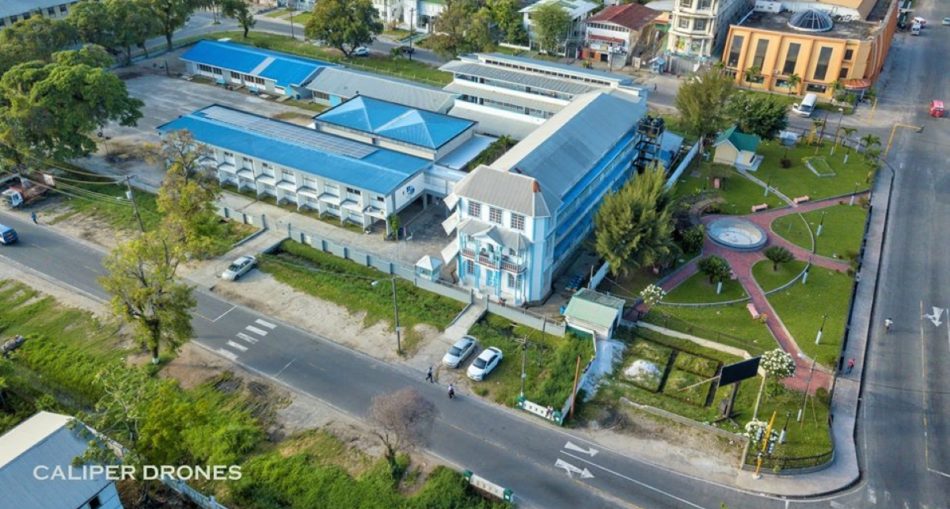The St. Stanislaus College is the third-highest ranked secondary school in the country, closely following the Queen’s College and Bishops’ High. This Grade A senior secondary school is one of the finest educational institutions in Guyana. Admission to the school is typically awarded through the National Grade Six Assessment (NGSA) and at the Lower 6th Form Level on the basis of Caribbean Secondary Education Certificate(CSEC) performance. First opened with only two boys Marshall and Pairadeau, St. Stanislaus College now hosts about five hundred students (500).
The first thing you’d notice when entering the compound is the statue of St. Stanislaus, the patron saint of youth, after whom the college was renamed. The high school was formerly a Roman Catholic school and an all-boys institution. The school has a rich history and has produced many outstanding individuals. The school has a farm – Saints Farm, a magazine called the Saints Magazine, a Wall of Fame where notable contributors are awarded and many Alumni association in countries like Canada, United States of America, Barbados and Antigua and Barbuda.

St. Stanislaus College – Photo by Caliper Drones
Origin of St. Stanislaus College
The Catholic Grammar School opened its door on the 1st May, 1866, with only two students. The school, as the names suggest, was a Roman Catholic school which was under the management of the Jesuits. The St. Stanislaus College underwent many changes in management and locations. The school was located in the Presbytery, next to the Church of Resurrection, where the Cathedral of Immaculate Conception now stands in Brickdam.
The Catholic Grammar School was placed under the care of Father Theobald Langton but later closed with the death of Fr. during the August Holidays. The school reopened with a total of seven (7) male students, under the charge of Fr. S. Bond. In October of 1866, Fr. C.K. Wilson took over the school which was transferred to the Sacred Heart Compound on Main St. Georgetown. Mr. C. B. King joined the school as an assistant, who later took over the institution. Again the school was moved to a new location, this time to Waterloo St. Georgetown.
The Catholic Grammar School was relocated to its original location, the Cathedral Presbytery in 1971 and Vicar-General Fr. E. Whytetook charge of the institution. In 1880 there was a total of fifteen (15) boys with a new Headmaster, Fr. Barraud who remained in his position of about twenty years (20). The number of students increased to twenty-seven (27) and later multiplied to seventy-two (72). More teachers were employed but the income was not enough to pay them and as such, they claimed a grant from the government.
The school remained for about seventeen years on the ground floor of the Presbytery. The conditions were barely adequate and the classes kept growing and so a new school was built. In 1897, the school moved to where the St. Mary’s School is currently located while the preparatory classes remained near the Presbytery.
The Catholics sent a petition to the then Governor, Sir Charles Cameron Lees but their request remained unfulfilled. Nevertheless, the school was moved to its present location at Brickdam in 1907. The Catholic Grammar School was renamed the St. Stanislaus College. The statue of St. Stanislaus, which had been presented to the school in honour of Fr. Barraoud’s contribution was moved and was installed at the front of the new St. Stanislaus College, where it remains to date. St. Stanislaus College became a government school in 1976 and all headteachers have since been appointed by the Ministry of Education.
St. Stanislaus Compound
The St. Stanislaus College comprises of several buildings including the Weld Wing (1928), Scannel Wing (1949), Hopkinson Wing (1972), a Hardcourt. A workshop was built in 1974 and there are IT Labs and Science Labs. Many students would scurry across the Bridge or pretend they were on an urgent errand since students were forbidden to use it. The Marrion Forum named after Fr. John Marion accommodates school events like PTA meetings, graduations, prize giving ceremonies and school assemblies.
On the northern wall, the Toronto chapter of the St. Stanislaus College, initiated the Wall of Fame, where black rectangular plaques with the names of notable students of the college and those who made a significant contribution to the college are mounted.

Aerial View of St. Stanislaus College – Photo by Caliper Drones
Motto of St. Stanislaus College
The motto of St. Stanislaus College was derived from the Latin phrase “Aeterna non Caduca” which means “Not for this life only but for eternity”. The school’s philosophy is to ensure the students and staff cooperate and work towards the betterment of the country.
College Crest of St. Stanislaus College
The College Crest is a blue and grey horseshoe which was taken from the Stanislaus Kostka family’s coat of arms.
Houses of the School
The symbol of the houses is a strip of colour which can be found on the school’s badge. Past students can testify to the competitiveness between the houses, especially between Butler and Galton houses.
The Houses are as follows:
- Butler (Blue)
- Galton (Green)
- Etheridge (Red)
- Weld (Yellow)
The St. Stanislaus College Alumni Association – Toronto Chapter
In 1992 the desire to reconnect with friends and peers of the St. Stanislaus College initiated the Toronto Chapter of the St. Stanislaus College Alumni Association. Two separate groups met at a Community Centre in the Autumn of 1992. Rupert De Castro offered accommodation of his boardroom in his office, located nearby, which later became the official address of the Association. The St. Stanislaus College Alumni Association – Toronto Chapter has contributed significantly to the development of the St. Stanislaus College. There are several fundraisers like the Last Lap Lime, annual Fall Dance and New Year’s Eve Ball. It was the Toronto Chapter of the St. Stanislaus College Alumni Association that created and funded the Wall of Fame.
The St. Stanislaus College New York Alumni Association
Founded in 2001, the St. Stanislaus College Alumni Association of New York comprised of a small group of former Saints who wanted to give back to the school. Their goal was to create a space or base where past teachers, alumni can keep in contact and raise funds for the St. Stanislaus College. Since then they have held many events like bowling, dinners and dances.
The St. Stanislaus College Barbados Alumni Association
The St. Stanislaus College Alumni Association of Barbados was founded in the year 1995. It enables the former members of staff and alumni to financially aid the school. They also contributed to the Wall of Fame.
The St. Stanislaus College Antigua and Barbuda Alumni Association
This was form in 2006 by a group of past students. Robin Shaw, formerly part of the Toronto Chapter initiated the body with support from the Toronto Chapter of St. Stanislaus College Alumni Association.
Saints Scouts
St. Stanislaus College Scout was started around 1913, when disaster struck In the form of fire and destroyed the Cathedral. To date Saints Scouts have positively impacted the community had has helped to foster friendships. Scouts take part in activities such as archery, canoeing, camping, cycling, fishing, swimming, hiking and numerous more.
Saints Farm
Located at 69 North Sophia, Greater Georgetown the St. Stanislaus College was founded in 1970 by Father Kenneth Khan. The aim of this establishment was to accommodate the practical training for students in the Agriculture Department of the school with the introduction of Agriculture to the secondary school’s curriculum. The farm was established with the help of the St. Stanislaus College Association and the labour of former and current students and parents. The St. Stanislaus Farm was opened in 1975 by the then Minister of Agriculture, Mr. Gavin Kennard.
The key component of the Complex is the poultry section which produces revenue from the sale of eggs and boiled. Sheep, ducks, and fish are also reared on the farm. In addition, to hydroponics, there are compost and humus production, vegetable, biogas and dairy units.
Interesting Tip
- The Complex of the St. Stanislaus Colege Farm is the only location when humus production, compost production and hydroponics are done on the same location.
The Saints Magazine
One of the traditions of St. Stanislaus College is the publication of St. Stanislaus College Magazine. The Magazine of the St. Stanislaus College was established after the St. Stanislaus College Association was founded in the year 1943. What started out as the College’s comprehensive newsletter became a magazine. As time passed the magazine was published more frequently, on a yearly basis which consisted of two sections; news of the college and the other, articles written by past students of St. Stanislaus College.
St. Stanislaus College
The school itself is a reminder of the dynamic history of St. Stanislaus College, resting on the solid and enduring foundation of the Jesuits. Past Headmasters and Headmistresses have shaped the culture of the school and likewise the lives of numerous students. Many students who have passed through St. Stanislaus, whether they completed one year, five years or six, always remain a “Saints” at heart. Most would say that their time at Saints has somehow helped shape the person they are today. Being a student at St. Stanislaus College is something you carry with you for the rest of your life and maybe even after, true to the motto.
Aeterna Non Caduca – Not For This Life Only, But For Eternity.
Article Reference
- Collins, N. (2006) Saints! The History Told St. Stanislaus College 140th Anniversary Magazine 12-13
- Fernandes, B (2006)The Saints Magazine Tradition – St. Stanislaus College 140th Anniversary Magazine 7
- https://en.wikipedia.org/wiki/St._Stanislaus_College_(Guyana)
- http://www.torontosaints.com/
- http://www.st-stanislaus-gy.com/History/SSC-History-2009.pdf








3 Comments